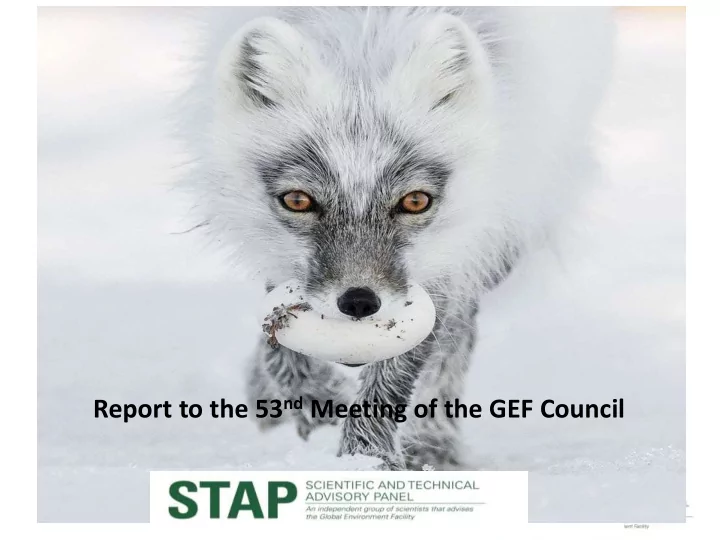

Report to the 53 nd Meeting of the GEF Council
Red Fox moving North into the range of the Arctic Fox
STAP Panel Members Thomas Lovejoy Michael Stocking Rosina Bierbaum Senior Advisor to Chair Senior Advisor to Chair Chair, USA Ferenc Toth Ralph Sims Annette Cowie Brian Child Ricardo Barra Blake Ratner Climate Change Land Degradation Climate Change Biodiversity Chemicals & Waste International Waters Adaptation Mitigation Australia South Africa Chile USA Hungary New Zealand
Presentation Outline Integration Assembly Papers: Circular Economy - Food, and Plastics Other STAP Assembly Papers Work Program Screening
Presentation Outline Integration Assembly Papers: Circular Economy - Food, and Plastics Other STAP Assembly Papers Work Program Screening
Integration in the GEF • 1992: GEF established to support biodiversity, climate change, and desertification conventions • 2000: OP 12 combined LD, BD, IW and CC • 2002: multifocal area portfolio initiated • 2014: Integrated Approach Pilot programs • 2015: SDGs
Top 5 2017 Global Risks in Terms of Impact
Benefits of System Integration • Understanding complexity • Addressing multiple issues simultaneously • Assessing feasibility of multiple goals • Identifying policies and strategies • Maximizing gains and minimizing costs Source: : https://www.thegef.org/council-meeting-documents/draft-stap-working-paper-why-scientific-community-moving-toward
OPS6: Examples of focal area integration • Mainstreaming biodiversity associated with better outcomes & evaluations better ratings • International waters - a catalyst for integration emphasizing learning & knowledge • Land degradation delivers GEBs in multiple FAs, and socio-economic benefits Source: http://www.gefieo.org/evaluations/ops6-gef-changing-environmental-finance-landscape
Essential characteristics of good MFA projects • The project objective would not be achievable by addressing a single focal area. • There are linkages and drivers of environmental degradation common to several focal areas. • Integration maximizes global environmental benefits and minimizes trade-offs. • A theory of change allows robust monitoring and assessment of outputs and specific indicators. Source: https://www.thegef.org/council-meeting-documents/draft-stap-working-paper-why-scientific-community-moving-toward
The GEF has two unique assets 1. Scale 2. Access to Governments Credits: NASA
Integration: IAPs Good Growth Sustainable Fostering Partnership: Cities – Sustainability Cultivating Harnessing and Resilience Sustainability Local Action for Food in the Global for Global Security in Supply Chain Commons Sub-Saharan Africa
6 key elements for successful integration 1. Apply systems thinking 2. Articulate a theory of change 3. Engage stakeholders 4. Assess resilience 5. Devise adaptive implementation pathways 6. Develop good quality KM and learning Source: : https://www.thegef.org/council-meeting-documents/draft-stap-working-paper-why-scientific-community-moving-toward
Presentation Outline Integration Assembly Papers: Circular Economy - Food, and Plastics Other STAP Assembly Papers Work Program Screening
Circular Economy
Agri-food Systems Chemic emical l fertil ilizer zer Soil il nutrie ients Agricultu lture and livest vestock ck produ oduct ction on Food od processin ocessing, g, Fresh shwa water Fossil sil fuels ls markets and retail ils Consumpt mption on Food od Waste Nutri rients are lost st to landfills, lls, rivers vers, lakes, es, ocea eans, s, incinera rators rs
What is the issue? • 1/3 of total end-use energy • 1/4 of total GHG emissions • 2/3 of terrestrial biodiversity loss • 1/3 of land degradation • depletion of 2/3 of commercial fish stocks • over- exploitation of 1/5 of the world’s aquifers
Agri-food Systems – more sustainable Sustain inabl ble e fertil ilizer zer Soil il nutrie ients use Agricultu lture and livest vestock ck produ oduct ctio ion Animal feeds, bio-soli solids, s, orga ganic ic residues, es, compos post, t, recov overy ery of Food od processin ocessing, g, Renewa wable e Fresh shwa water markets and phos osph phor orus s & minerals Energy retail ils Consumpt mption on Food od Waste Nutrie ients are lost st to landfill lls, s, river vers, lakes, es, ocea eans, s, incinera inerator ors
What is the solution? • Closing the nutrient cycle • Reducing competition for productive land • Reducing chemical fertilizers • Reducing freshwater use • Maintaining sustainable agro-ecological systems • Deploying low-carbon energy, waste for energy • Producing food within the urban landscape
Presentation Outline Integration Assembly Papers: Circular Economy - Food, and Plastics ics Other STAP Assembly Papers Work Program Screening
Plastics
What is the issue? • Plastic production increased 20x 1964 -2015 • Expected to double in 20 yrs; quadruple 2050 • Some contain toxic chemicals (POPs) • Stay in environment for up to 500 yrs • End up in the food chain • Projected to use 20% of oil by 2050 Source: World Economic Forum: http://www3.weforum.org/docs/WEF_The_New_Plastics_Economy.pdf
What is the issue? • Plastic production increased 20x 1964 -2015 • Expected to double in 20 yrs; quadruple 2050 • Some contain toxic chemicals (POPs) • Stay in environment for up to 500 yrs • End up in the food chain • Projected to use 1/5 of oil by 2050
Photo credit: Justin Hofman
What is the solution? Design for longevity, reusability, waste prevention – Encourage production from biodegradable materials – Use waste as a resource – Recover for reintroduction back to the economy – Provide incentives for recycling and reuse – Support innovative research – Create a supportive policy environment
Presentation Outline Integration Assembly Papers: Circular Economy - Food, and Plastics Other STAP Assembly Papers Work Program Screening
2018 STAP Assembly Papers Five other papers for GEF Assembly: 1. Environmental Security 2. Novel Entities 3. Innovation 4. Local Commons/Global Benefits 5. Key interactions between MEAs and SDGs 6. Science of integrated approaches 7. Knowledge Management 8. Circular Economy: Food and Plastics
Observations on the GEF Work Program Ratin ing
Observations from Work Program • 82 projects screened representing about $500m. • 6 majors (7%), slightly lower % than usual. • Good od projec jects ts: clearly described, with a good theory of change; demonstrate strong understanding of the social-ecological system; build on strong baselines; well-designed interventions; engage all stakeholders; and capture learning. • Some proj oject cts s would ld benefit it fr from: a clearer logic; assumptions substantiated; clearly defined strategies to address key drivers; resilience and adaptive management.
Questions?
Recommend
More recommend